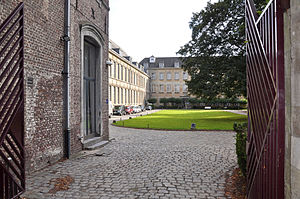Old Drongen Abbey
The old Drongen Abbey (Dutch: Oude Abdij van Drongen ) is a former Premonstratensian monastery on the outskirts of Ghent ( Belgium ), which is now used as a retreat and conference center.
history
The Legend of the Holy founded. Amand of Maastricht (600-679 n. Chr.) On an arm of the Leie in the 7th century a monk's cell . Historical references to the existence of a monastic community can, however, first be found for the 10th century. The location gained its decisive boost in the 12th century: In 1136 Iwein van Aalst (d. 1145) founded a monastery in Salegem, whose members followed the Augustinian rule ; In 1138 this community settled in Drongen , where they adopted the Premonstratensian rule.
In 1566 parts of the abbey - in particular its interior, relics and parts of the library - fell victim to the iconoclasm of the Reformation . In the turmoil of the religious conflicts and in the course of the uprising of the Netherlands against Spanish rule under Philip II , the abbey was occupied by Calvinists in 1572 ; the monastic community was abolished. Only after the Duke of Parma Alexander Farnese (1545-1592) Ghent had retaken and the surrounding area for the Spanish crown, the church structures have also been restored, but the restoration succeeded the Convention - also due to the now incurred structural damage - only 1698th
As a result of the French Revolution , the abbey was finally dissolved in 1797; the buildings and lands were confiscated and sold to private individuals. The convent church was demolished.
In 1837 the Belgian Province of the Jesuit Order initially acquired individual parts of the building, later the entire complex and set up a training center ( novitiate ) there. Later, the complex also housed a junior and tertiary degree, where famous members of the order such as Constant Lievens (1856-1893) and Alberto Hurtado (1901-1952) also spent part of their religious education. At the same time, parts of the complex were used as a retreat center, the v. a. by secular priests, but also by lay people. From 1858–1859 a parish church in late classicist style (Sint-Gerolfkerk) was added to the complex . Inside the old abbey, a new chapel in neo-Gothic style was built in 1878 according to plans by Jean-Baptiste Béthune .
As a result of declining offspring, the Jesuit order closed the juniorate in 1958 and the tertiary in 1968. The novitiate was moved in 1967. The retreat was continued. In the 1990s, it became a retreat and conference center.
Present shape
Most of the old monastery complex, the total area of which today, including the garden area, is 10 hectares, today houses the retreat and education house Oude Abdij Drongen , which is used for retreats, Ignatian retreats and further training ( Gregorian chant , Biblical Greek , ethics , spirituality etc.), lectures and similar offers are used. The center, which is run by a director, has overnight rooms, conference and dining rooms as well as three chapels ; The neo-Gothic chapel, built in 1878 and now mainly used for concerts, contains a romantic organ from the workshop of Charles Anneessen with 15 registers and 1104 pipes (built in 1891; remodeled in 1939).
On the site of the old abbey there is also a Jesuit community, which (2016) comprises three people, and a spiritual community for the integration of the disabled ( L'Arche ). The entire complex has been a listed building since 1998 .
literature
- Luc Vints / Maria Kelly: De oude abdij van Drongen: eleven eeuwen divorced . Leuven 2006.
- Gaston de Smet, Marie Christine Laleman: Gent, onbekende rijkdom . Ghent 1990.
Web links
Individual evidence
- ↑ Archive link ( Memento from April 10, 2016 in the Internet Archive )
- ↑ Archive link ( Memento from April 10, 2016 in the Internet Archive )
Coordinates: 51 ° 3 '0.2 " N , 3 ° 39' 52.9" E
